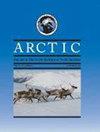横跨哈德逊湾西北部罗伊斯欢迎湾的冰桥(Nunniq)的间歇形成及其对当地因纽特猎人的使用
IF 0.8
4区 地球科学
Q4 ENVIRONMENTAL SCIENCES
引用次数: 2
摘要
冰桥是海冰在河道内固化并保持不动时形成的独特特征。它们在整个北极的许多地方形成,并以背风侧形成的多冰湖而闻名。然而,冰桥也提供了一个临时平台,人类和野生动物可以利用它来穿越否则无法通行的渠道。努纳武特珊瑚港的因纽特人世世代代都用一座冰桥穿过罗埃斯欢迎湾,扩大他们的狩猎范围,尽管他们报告说这座桥大约每四年才形成一次。因纽特人和科学界都感兴趣的是,为什么这座桥的形成如此间歇性,通过什么机制,以及频率是否会随着持续的变暖和海冰的减少而改变。利用卫星图像,我们确定了这座桥在过去50年(1971 - 2020年)中的14年形成。一般来说,桥在1月到3月之间形成,在一个与小潮同时发生的寒冷时期,在地面风从盛行的北风(沿航道)转向西北风(跨航道)之后。这种旋转压缩了南安普敦岛上现有的浮冰,在那里,由于海峡沿线的平静风和低潮差,浮冰保持静止,并在冷空气温度下合并。崩解发生在6月中旬至7月初融化开始后。总的来说,当一组特定的条件同时出现时,桥梁就形成了;然而,气候变暖,特别是非常寒冷的日子减少,冰季缩短可能会影响桥梁形成的频率,从而限制因纽特人的旅行。本文章由计算机程序翻译,如有差异,请以英文原文为准。
On the Intermittent Formation of an Ice Bridge (Nunniq) across Roes Welcome Sound, Northwestern Hudson Bay, and Its Use to Local Inuit Hunters
Ice bridges are unique features that form when sea ice consolidates and remains immobilized within channels. They form in many locations throughout the Arctic and are typically noted for the polynyas that form on their lee side. However, ice bridges also provide a temporary platform that may be used by both humans and wildlife to cross otherwise impassable channels. For generations, Inuit in Coral Harbour, Nunavut, have used an ice bridge to cross Roes Welcome Sound and expand their hunting territory, though they report that the bridge only forms approximately every four years. Of interest both to Inuit and the scientific community is why the bridge forms so intermittently, by what mechanisms, and whether the frequency will change with ongoing warming and sea ice loss. Using satellite imagery, we determined that the bridge formed during 14 of the past 50 years (1971 – 2020). Generally, the bridge forms between January and March, during a cold period that coincides with neap tide, and after surface winds have rotated from the prevailing northerly (along-channel) winds to west-northwesterly (across-channel) winds. This rotation compresses the existing ice pack against Southampton Island, where it remains stationary because of the calm along-channel winds and low tidal range, and coalesces under cold air temperatures. Breakup occurs between mid-June and early July after the onset of melt. Overall, the bridge forms when a specific set of conditions occur simultaneously; however, a warming climate, specifically a reduction in very cold days, and shorter ice season may affect the frequency of bridge formation, thereby limiting Inuit travel.
求助全文
通过发布文献求助,成功后即可免费获取论文全文。
去求助
来源期刊

Arctic
地学-环境科学
CiteScore
2.30
自引率
0.00%
发文量
51
审稿时长
6-12 weeks
期刊介绍:
Arctic is a peer-reviewed, primary research journal that publishes the results of scientific research
from all areas of Arctic scholarship. Original scholarly papers in the physical, social, and biological
sciences, humanities, engineering, and technology are included, as are book reviews,
commentaries, letters to the editor, and profiles of significant people, places, or events of northern
interest
 求助内容:
求助内容: 应助结果提醒方式:
应助结果提醒方式:


